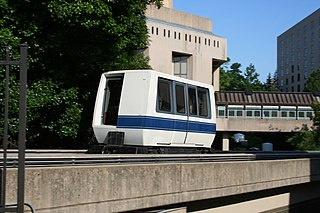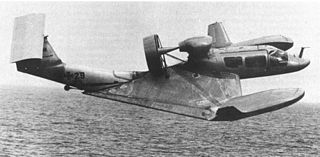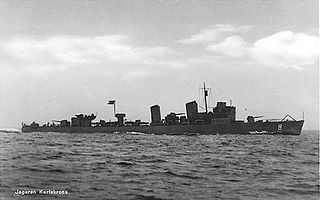
A hovercraft, also known as an air-cushion vehicle or ACV, is an amphibious craft capable of travelling over land, water, mud, ice, and other surfaces.

The Swedish Navy is the naval branch of the Swedish Armed Forces. It is composed of surface and submarine naval units – the Fleet – as well as marine units, the Amphibious Corps.

The Visby class is a warship in use by the Swedish Navy. It is the latest class of corvette adopted by the navy after the Göteborg and Stockholm-class corvettes. Its design emphasizes low visibility radar cross-section and infrared signature, and the class has received widespread international attention because of its capabilities as a stealth ship.

The Bristol Proteus was the Bristol Engine Company's first mass-produced gas turbine engine design, a turboprop that delivered just over 4,000 hp (3,000 kW). The Proteus was a reverse-flow gas turbine. Because the second turbine drove no compressor stages, but only the propeller, this engine was classified as a free-turbine. It powered the Bristol Britannia airliner, small naval patrol craft, hovercraft and electrical generating sets. It was also used to power a land-speed record car, the Bluebird-Proteus CN7. After the merger of Bristol with Armstrong Siddeley the engine became the Bristol Siddeley Proteus, and later the Rolls-Royce Proteus. The Proteus was to have been superseded by the Bristol Orion which would have given a Britannia a 75% increase in power for cruising faster.

The Saab 91 Safir is a three or four seater, single engine trainer aircraft. The Safir was built by Saab AB in Linköping, Sweden and by De Schelde in Dordrecht, Netherlands.

A Surface Effect Ship (SES) or Sidewall Hovercraft is a watercraft that has both an air cushion, like a hovercraft, and twin hulls, like a catamaran. When the air cushion is in use, a small portion of the twin hulls remains in the water. When the air cushion is turned off ("off-cushion" or "hull borne"), the full weight of the vessel is supported by the buoyancy of the twin hulls.

HSwMS Sjölejonet was the lead ship of a class of nine naval submarines in the service of the Swedish Navy from just before World War II into the early Cold War. The submarines were ordered in response to the rising German threat to the south in the interwar period. Sjölejonet remained in service until 1959 and was sold for scrap in 1962.
Melville Whitnel Beardsley was the American inventor and aeronautical engineer whose pioneering efforts may have contributed to the invention of the hovercraft.

The Piasecki VZ-8 Airgeep was a prototype vertical takeoff and landing (VTOL) aircraft developed by Piasecki Aircraft. The Airgeep was developed to fulfill a U.S. Army Transportation Research Command contract for a flying jeep in 1957. The flying jeep was envisioned to be smaller and easier to fly than a helicopter.

A ground-effect vehicle (GEV), also called a wing-in-ground-effect (WIG), ground-effect craft, wingship, flarecraft or ekranoplan, is a vehicle that is able to move over the surface by gaining support from the reactions of the air against the surface of the earth or water. Typically, it is designed to glide over a level surface by making use of ground effect, the aerodynamic interaction between the moving wing and the surface below. Some models can operate over any flat area such as frozen lakes or flat plains similar to a hovercraft.

The Colonial Model C-1 Skimmer was an American small single-engined amphibian flying boat built by the Colonial Aircraft Corporation. It was the start of a line of very similar aircraft designed by David Thurston.

The Saunders-Roe SR.N6 hovercraft was essentially a larger version of the earlier SR.N5 series. It incorporated several features that resulted in the type becoming one of the most produced and commercially successful hovercraft designs in the world.

Tracked Hovercraft was an experimental high speed train developed in the United Kingdom during the 1960s. It combined two British inventions, the hovercraft and linear induction motor, in an effort to produce a train system that would provide 250 mph (400 km/h) inter-city service with lowered capital costs compared to other high-speed solutions. Substantially similar to the French Aérotrain and other hovertrain systems of the 1960s, Tracked Hovercraft suffered a similar fate to these projects when it was cancelled as a part of wide budget cuts in 1973.

A hovertrain is a type of high-speed train that replaces conventional steel wheels with hovercraft lift pads, and the conventional railway bed with a paved road-like surface, known as the track or guideway. The concept aims to eliminate rolling resistance and allow very high performance, while also simplifying the infrastructure needed to lay new lines. Hovertrain is a generic term, and the vehicles are more commonly referred to by their project names where they were developed. In the UK they are known as tracked hovercraft, in the US they are tracked air-cushion vehicles. The first hovertrain was developed by Jean Bertin (1917-1975) in France, where they were marketed as the Aérotrain before being abandoned by the French government.
The Collins X-112 was an experimental two-seat ground-effect vehicle, designed by Alexander Lippisch in the United States in the early 1960s to test his thick reverse delta wing concept.

The RFB X-114 was a ground-effect craft, designed chiefly to operate over water but capable of flight at higher altitudes where required, carrying five or six passengers or freight along coasts and capable of surveillance duties. One was evaluated by the German military in the late 1970s, but no orders followed.

SaabO is a caravan created and manufactured by Saab from 1964-1968 in Ljunga, outside Norrköping, Sweden.

Oscar Parkes was a Royal Navy surgeon, naval historian, marine artist, and editor of Jane's Fighting Ships from 1918 to 1935. He was an associate of the Royal Institution of Naval Architects. The Imperial War Museum and the National Maritime Museum have permanent collections of his artwork. His book British Battleships: "Warrior", 1860 to "Vanguard", 1950. A History of Design, Construction and Armament is regarded as a definitive source.

HSwMS Karlskrona was a destroyer of the Royal Swedish Navy that served during the Second World War and in the Cold War. The fourth member of the Göteborg or city class, which was designed as an improvement on the previous Ehrensköld class, Karlskrona was launched on 16 June 1939. The destroyer served in the Coastal Fleet during the war, protecting Swedish neutrality and escorting convoys. After the war, the ship was upgraded between 1950 and 1951 with enhanced fire control and an armament improved with the introduction of the Bofors 40 mm anti-aircraft gun. Ten years later, in 1961, Karlskrona was designated a fast anti-submarine frigate and the torpedo tubes were replaced by Squid mortars. The vessel was decommissioned on 1 July 1974 and broken up in 1979.

HSwMS Gävle was a destroyer of the Royal Swedish Navy that served during the Second World War and in the Cold War. The fifth member of the Göteborg or city class, which was designed as an improvement on the previous Ehrensköld class, Gävle was launched on 25 September 1940. The destroyer served in the Coastal Fleet during the war, protecting Swedish neutrality and assisting in the 1944 evacuation of Estonia. After the conflict had ceased, the ship was upgraded with enhanced fire control and an armament improved with the introduction of the Bofors 40 mm anti-aircraft gun between 1950 and 1951. Ten years later, in 1961, Gävle was rearmed as a fast anti-submarine frigate and the torpedo tubes were replaced by Squid mortars. After being decommissioned on 6 December 1968, the vessel helped in the testing of the equipment for the Oskarshamn Nuclear Power Plant, finally being broken up in 1972.



















